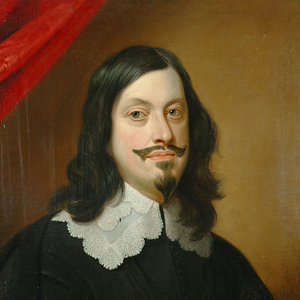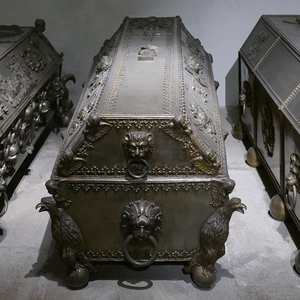
Emperor Ferdinand III.
*13.07.1608 Graz - †02.04.1657 Vienna
Emperor of the Holy Roman Empire
Archduke of Austria
King of Hungary
King of Bohemia
Emperor Ferdinand III. was the second son of Ferdinand II. and his wife Maria Anna, daughter of William, Duke of Bavaria.
His life is often viewed in conjunction with that of his father, and in terms of political actions, people refer to the “two Ferdinands.” However, the two were not alike in appearance or character. Ferdinand III. continued the Counter-Reformation, but with less rigorous means than his father.
After the early death of his older brother Johann Karl, he became heir to the throne and found in Baron Christoph Simon von Thun, a member of the Order of Malta, a court master and advisor experienced in the art of war. In 1625, Ferdinand became King of Hungary and in 1627 King of Bohemia.
After Wallenstein's assassination in 1634, he became commander-in-chief of the imperial troops. Together with the Spanish army of his relative, General Infante Ferdinand, he defeated the Swedes and French in the Battle of Nördlingen. None other than the Flemish painter Peter Paul Rubens, who himself was involved as a diplomat in efforts to end the seemingly endless war, immortalized the meeting of the two young rulers at Nördlingen (painting collection of the Kunsthistorisches Museum Vienna).
In 1636, Ferdinand was elected Holy Roman Emperor. In order to secure peace, his main goal was to permanently overcome the dangerous superiority of France and Sweden. While the war was still raging, peace negotiations began in Münster and Osnabrück in 1645.
At that time, a political document caused quite a stir. It was the “Dissertatio de ratione status in imperio nostro romano-germanico” by a certain Hippolytus a Lapide. This pseudonym concealed the Swedish councilor and historiographer Philipp von Chemnitz. In his document, he developed theories about the nature of the German imperial constitution, pointed out its shortcomings, and at the same time drew the attention of the German imperial princes to their privileges vis-à-vis the emperor. The publication weakened the emperor's position and subsequently prevented the establishment of a central authority of the great powers.
The Peace of Westphalia of October 24, 1648—signed by Ferdinand III. and his allies on the one hand and King Louis XIV. of France and his allies on the other—comprised 120 paragraphs, was declared the “eternal constitution of the empire,” and determined political agreements in the empire for over 150 years. The Austrian-Habsburg lands, which had previously only formed a loose confederation, now became the “House of Austria,” or “Casa d'Austria” – a Spanish term that had been in use since 1400.
In the Habsburg lands, the emperor was the absolute ruler, which paved the way for Austria's unique development. Within the empire itself, the territorial principalities prevailed over the central authority, and it became a confederation of sovereign states. The emperor's power remained untouched externally, but in reality it became increasingly diminished.
Foreign envoys reported that Ferdinand III. led an exemplary family life, had a moderate disposition, and was very likeable. Although he did not match his father in terms of military talent and political foresight, he was said to be righteous and to make sincere efforts to achieve peace and justice in accordance with his motto “pietate et justitia” – through piety and justice.
He spoke seven languages (Latin, German, Spanish, Italian, French, Czech, and Hungarian) and was very interested in science and art. Because of his interest in military theory, the important commander Raimund Prince of Montecuccoli (1609-1680) dedicated a treatise on military science to him.
In Vienna in 1657, Ferdinand founded a literary academy based on the Italian model, where music was also cultivated. This prompted his brother, Archduke Leopold Wilhelm, himself a poet and art collector, to remark: “(...) fonda il Cesare il scettro e su la spada e sul canora plettro” – “The emperor bases his sceptre on the lyre and the sword”. It was said of Ferdinand III. as a musician and composer: “(...) that the emperor is probably unrivalled among all rulers in this respect.” His “Drama musicum,” composed in Italian, is the first work written on German-speaking soil that was modeled on the newly created Italian opera. His church compositions include a five-part mass, four motets, ten hymns, a Popule meus, and a Stabat mater.
Ferdinand III. found the ideal complement to his personal interests in his third wife, Eleonora Gonzaga (1630-1686), a daughter of Charles II., Duke of Mantua and Montferrat, and Maria Gonzaga. Three daughters and one son were born from this marriage. Eleonora combined a scientific education, which was rare at the time, with diverse artistic interests.
The emperor had a deeply personal connection to the Capuchin Crypt. Here, he had two wives and five of his children buried, most recently the heir to the throne, Ferdinand IV., who died at the age of 21, in the small vault where the remains of the founders Anna and Matthias had rested since 1633.
On St. Anthony's Day in 1656, during a visit, he told the Father Guardian that he too would like to be buried here one day, thus providing the first important impetus for the creation of a Habsburg family burial vault.
Ferdinand died the following spring. At first, his coffin had to be placed across the others, “because there was no more room in it.” In the same year, his son and successor Leopold I. ordered the expansion of the crypt.

The sarcophagus
Ferdinand's coffin is the work of Baptist Zacharias Lauffer. It represents the second basic form of all sarcophagi in the crypt, a wooden coffin shape modeled on the six boards of a wooden coffin. Although it still displays the calm form of the Renaissance, its decoration already contains early Baroque elements.
The coffin is carried by eagles resting on balls. The side walls are decorated with flower garlands and lion's head handles. Faces, crossed bones with skulls, festoons, angel heads, and rich leaf ornamentation already refer to the symbolic language of the Baroque. The relief in the center shows a pelican holding out its open breast to its young. This is the widespread medieval symbol for the sacrificial death of Christ. The palmette decoration on the edges and the hint of a curtain motif on the sides of the lid are also among the new forms of expression.
On the lid is the imperial eagle with a small crowned breast shield displaying the Austrian coat of arms, surrounded by the chain of the Order of the Golden Fleece. The crossbar of the Austrian coat of arms contains the monogram F(erdinand) III. Below it is Christ on the cross, with Mary at his feet.
The inscription on the coffin lid reads:
FERDINANDUS III ROM. IMPERATOR, HUNG: ET BOH: REX ARCHI: DUX AUSTRIAE ETC FERDINANDI II: CAESARIS FILIUS, EJUSQUE IN IMPERIO, REGNISQUE SUCCESSOR NATUS GRAECII XIII. JULII AO: MDCVIII. DENATUS II. APRILIS: MDCLVII
Ferdinand III., Holy Roman Emperor, King of Hungary and Bohemia, Archduke of Austria, etc., son of Emperor Ferdinand II. and his successor as emperor and king, born in Graz on July 13, 1608, died on April 2, 1657.
On March 5, 1852, the remains of Emperor Ferdinand III. were removed for repairs to the sarcophagus. "The body was decayed, but the Spanish clothing was preserved – probably once brown in color, with shoes that had meshes like knee bands. The head was covered with a beret, and around the neck was a well-preserved small enamel insignia of the Order of the Golden Fleece on a brown ribbon; there was also probably once a wax cross between the hands."
On February 8, 1990, after a year of work, another restoration was completed. The remains of Ferdinand III were first placed in a wooden chest, which was then inserted into the metal sarcophagus.
The weave of the elegant brocade jacket (black Spanish cloak) reaching to the hips and the trouser legs, which were tied together at the lower leg, were still clearly visible. A light-colored insole suggested that the shoes had been elegant and narrow, covering the ankles like cuffs and fastened to the lower leg with ribbons.
A small, approximately 1 1/2 cm Toison Order insignia on a ribbon lay at chest height. Beneath it were scattered 10 to 15 brown wooden beads with a diameter of about one centimeter, which had probably been part of a rosary.
The emperor must have been quite tall.
The coffin was fitted with four locks, and the corresponding keys are all kept in the monastery. The key in the Vienna Treasury, which had previously been attributed to the coffin of Ferdinand III., probably belonged to the former Baroque grille between the crypts of Leopold and Charles.